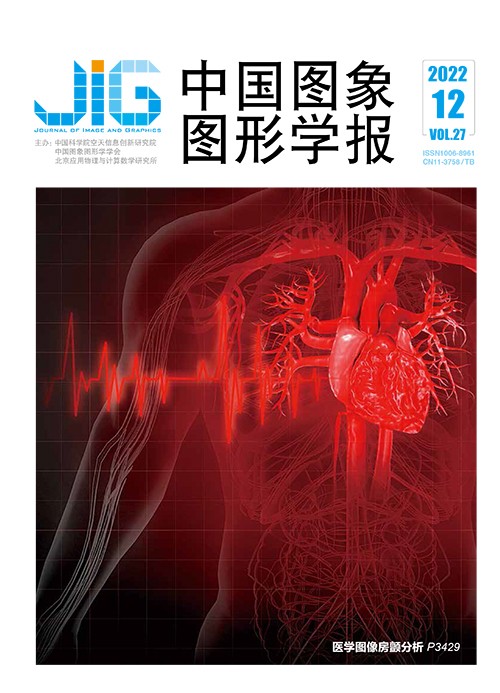
掩膜融合下的人脸图像质量评价方法
摘 要
目的 人脸识别技术已经在众多领域中得到广泛应用,然而现有识别方法对于人脸图像的质量要求普遍较高,低质量图像会严重影响系统的识别性能,产生误判。人脸图像质量评价方法可用于高质量图像的筛选,对改善人脸识别系统的性能有重要作用。不同于传统的图像质量评价,人脸图像质量评价是一种可用性评价,目前对其研究较少。人们在进行人脸识别时往往主要通过眼睛、鼻子、嘴等关键区域;基于此,本文提出了一种基于掩膜的人脸图像质量无参考评价方法,通过挖掘脸部关键区域对人脸识别算法的影响计算人脸图像质量。方法 人脸识别方法通常需要比较输入人脸图像和高质量基准图像之间的特征相似度;本文从另一个角度出发,在输入人脸图像的基础上构造低可用性图像作为伪参考,并通过计算输入人脸图像和伪参考图像间的相似性获得输入人脸图像的质量评价分数。具体地,对一幅输入的人脸图像,首先对其关键区域添加掩膜获得低可用性质量的掩膜人脸图像,然后将输入图像和掩膜图像输入特征提取网络以获得人脸特征,最后计算特征间的距离获得输入人脸图像的质量分数。结果 用AOC(错误拒绝曲线围成的区域面积)作为评估指标,在5个数据集上将本文方法与其他主流的人脸质量评价方法进行了充分比较,在LFW(labeled faces in the wild)数据集中比性能第2的模型提升了14.8%,在CelebA(celebFaces attribute)数据集中提升了0.1%,在DDFace(diversified distortion face)数据集中提升了2.9%,在VGGFace2(Visual Geometry Group Face2)数据集中提升了3.7%,在CASIA-WebFace(Institute of Automation, Chinese Academy of Science-Website Face)数据集中提升了4.9%。结论 本文提出的基于掩膜的人脸图像质量评价方法,充分利用了人脸识别的关键性区域,将人脸识别的特点融入到人脸图像质量评价算法的设计中,能够在不需要参考图像的条件下准确预测出不同失真程度下的人脸图像质量分数,并且性能优于目前的主流方法。
关键词
Mask-fused human face image quality assessment method
Li Leida, Yin Yangtao, Wu Jinjian, Dong Weisheng, Shi Guangming(School of Artificial Intelligence, Xidian University, Xi'an 710071, China) Abstract
Objective Human face recognition has been developing for biometrics applications like online payment and security. Face-related recognition systems are usually deployed in an open environment in reality, which is challenged for the robustness problem. The changing external environment (e.g., improper exposure, poor lighting, extreme weather conditions, background interference), can intervene diversified distortions to the face images like low contrast, blurring and occlusion, which significantly degrades the performance of the face-related recognition system. Therefore, an accurate face image quality assessment method is highly required to improve the performance of the face recognition system from two perspectives as mentioned below: 1) face-related image quality model can be used to filter out low-quality face images since the performance of face recognition systems is often affected by low-quality images, thus avoiding invalid recognition and improving the recognition efficiency. 2) Traditional face recognition features can be enhanced in terms of the integrated facial quality features. In contrast to the traditional image quality assessment approaches, face-related image quality assessment can be achieved with specific face recognition algorithms only. The existing face-related image quality model scan be divided into handcrafted feature-based and deep learning-based. Method We develop a new mask-based method for face-related image quality assessment. From the perspective of human recognition, the quality of a face image is mainly determined by the key regions of the face image (eyes, nose, and mouth). Changes in these regions will have different impacts on the recognition performance for face-related images with multi-level quality. A mask added on these regions will also have different impacts for different face images. For example, high-quality images masked tends to have greater impact on the recognition performance compared with low-quality face images. Such a mask can be designed to cover the key regions, and the quality of a face image can be achieved by measuring the influence of the masking operation. Our human face-related image quality model can be segmented into two categories: 1) the masking operation on face images; 2) the quality score regression. Specifically, the mask is added to the key regions at first for an input face image to be evaluated. Next the face image pair is obtained containing the input image and the masked image. Finally, image pair is input into the deep feature extraction module, producing the qualified features. The objective quality score of the input face image is obtained in terms of the feature pair regression. Our method is called mask-based face image quality (MFIQ). For model training, we build a new DDFace(Diversified Distortion Face) database, which contains a total of 350 000 distorted face images of 1 000 people. We use 280 000 face images as the training set and the rest of it as the testing set. We train the model for 40 epochs with the learning rate 0.001 and batch size 32. Result In the experiments, five face image datasets are used, including our DDFace-built and four existing face recognition datasets like LFW(Labeled Faces in the Wild), VGGFace2(Visual Geometry Group Face2), CASIA-WebFace(Institute of Automation Chinese Academy of Science-Website Face) and CelebA(CelebFaces Attribute). Our proposed MFIQ model is compared with the popular deep face image quality models, including face quality net-v0 (FaceQnet-v0), face quality net-v1(FaceQnet-v1) and stochastic embedding robustness-face image quality (SER-FIQ). Under the metric area over curve(AOC), our model performance is improved by 14.8%, 0.1%, 2.9%, 3.7% and 4.9% in comparison with LFW, CelebA, DDFace, VGGFace2 and CASIA-WebFace databases, respectively. Furthermore, our MFIQ model is used to predict the face-related image quality in different datasets and the quality distributions of images are calculated. The experimental results show that our distributions predicted is close to the real distributions. Our MFIQ model performance is also compared with the other three models according to face-related images evaluation from singles and multiples. The results show that the proposed MFIQ performs better than SER-FIQ, FaceQnet-v0 and FaceQnet-v1. Conclusion Our research potentials are focused on more robustness and distinguishing ability for the key elements of multiple-level distorted images.
Keywords
face recognition image quality assessment face image utility quality no reference mask pseudo reference
|



 中国图象图形学报 │ 京ICP备05080539号-4 │ 本系统由
中国图象图形学报 │ 京ICP备05080539号-4 │ 本系统由